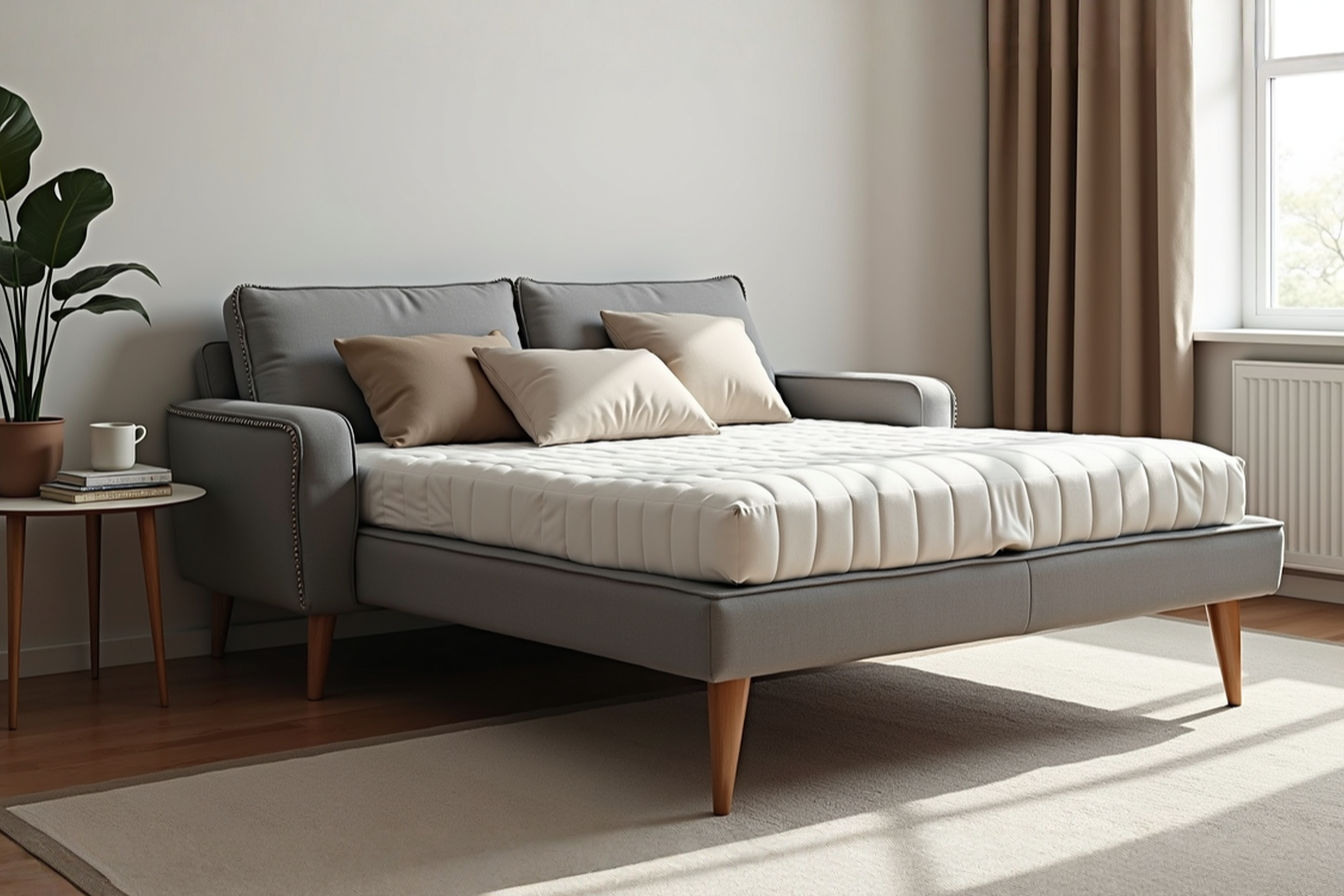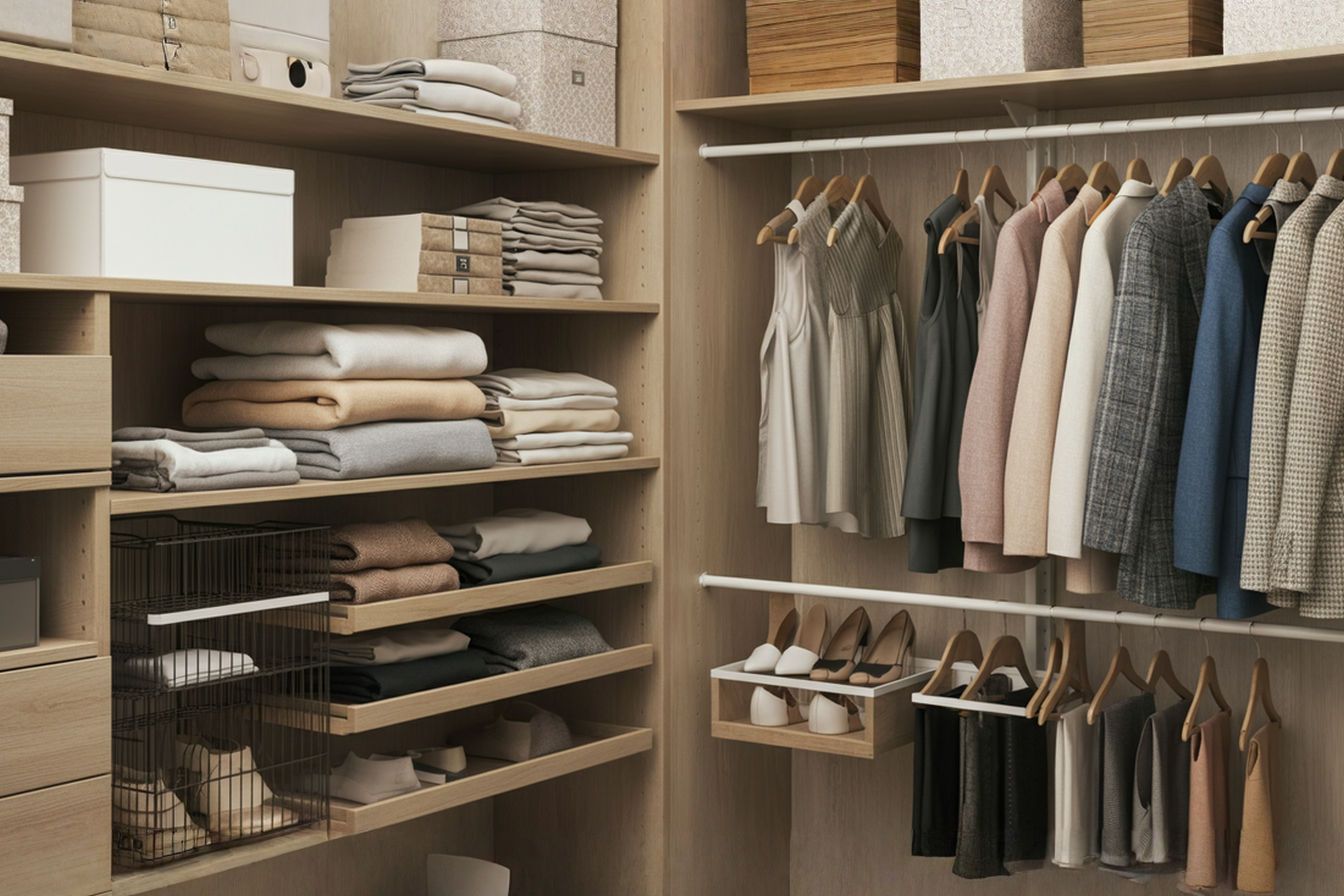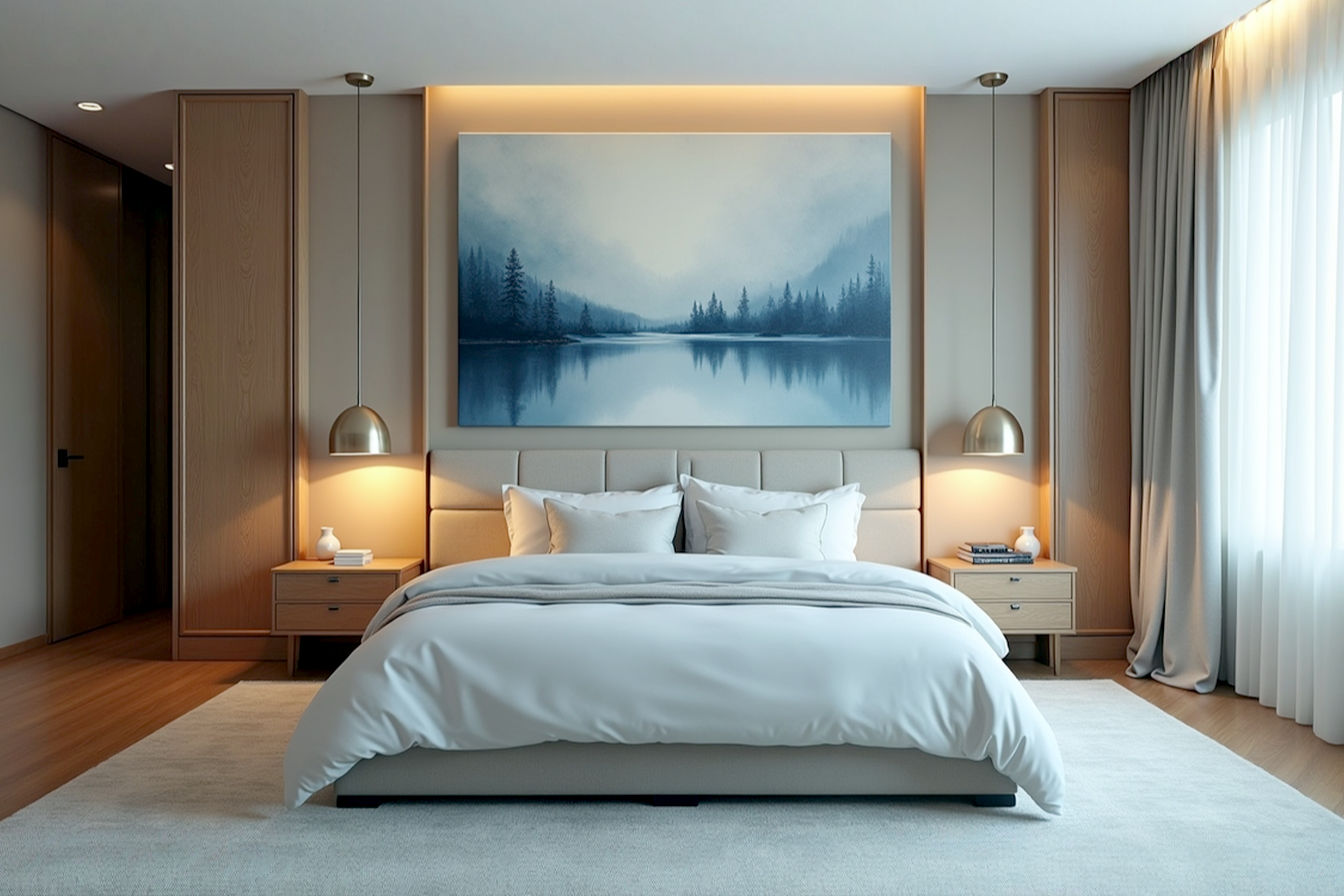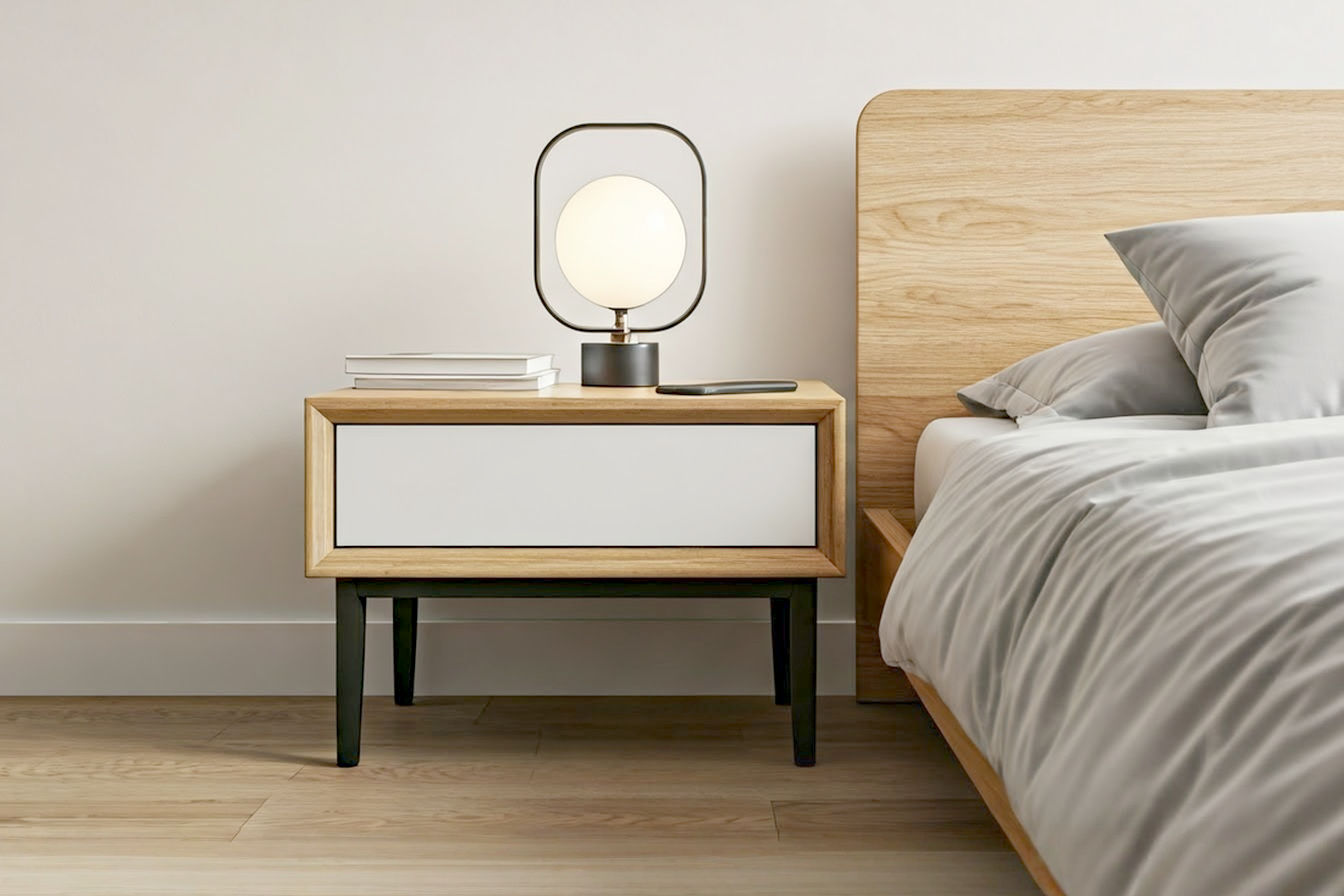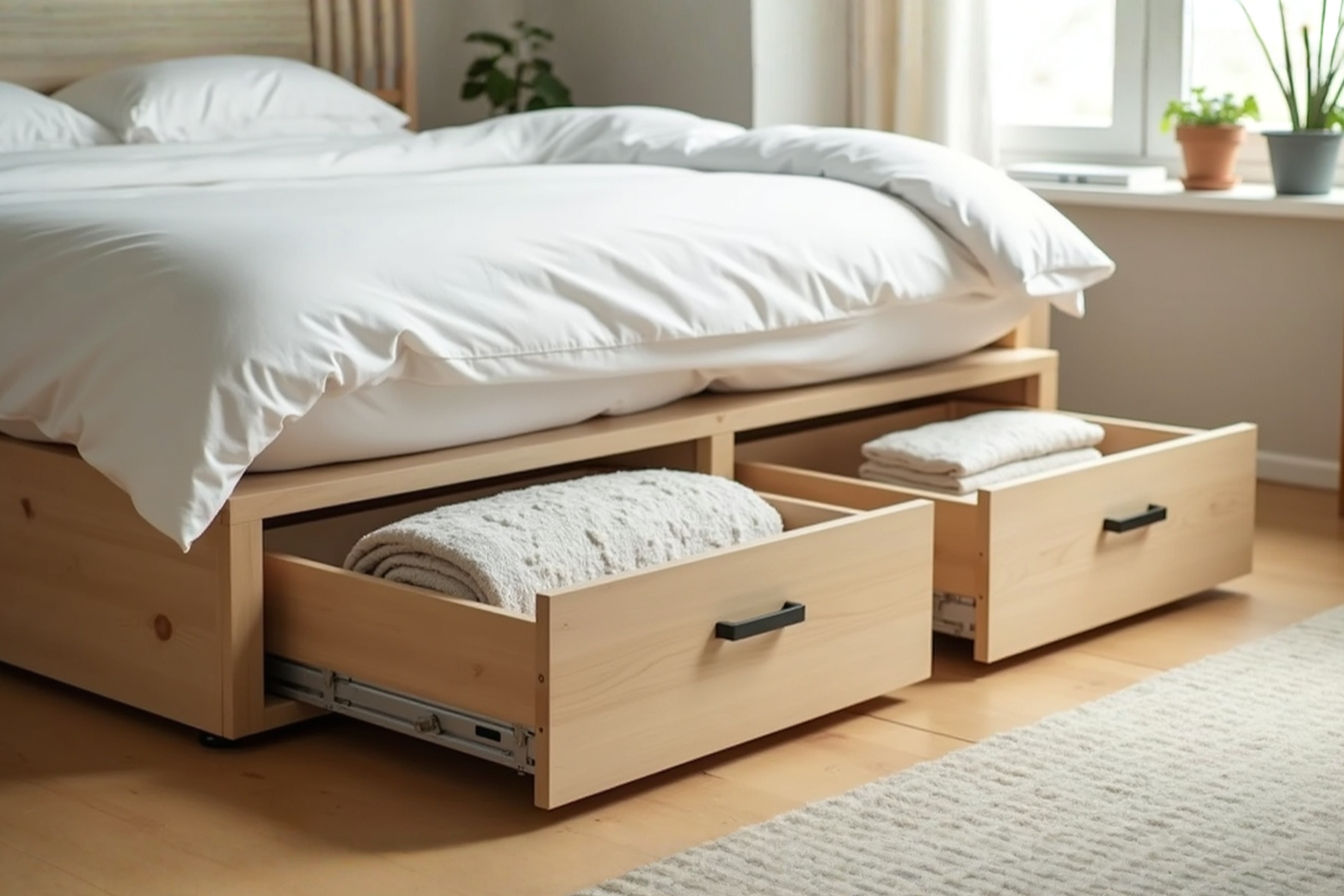Unlock Hidden Space: Creative Uses for the Area Underneath Your Bed
That empty space under your bed? It’s prime real estate! Learn how to unlock hidden storage and organize like a pro…
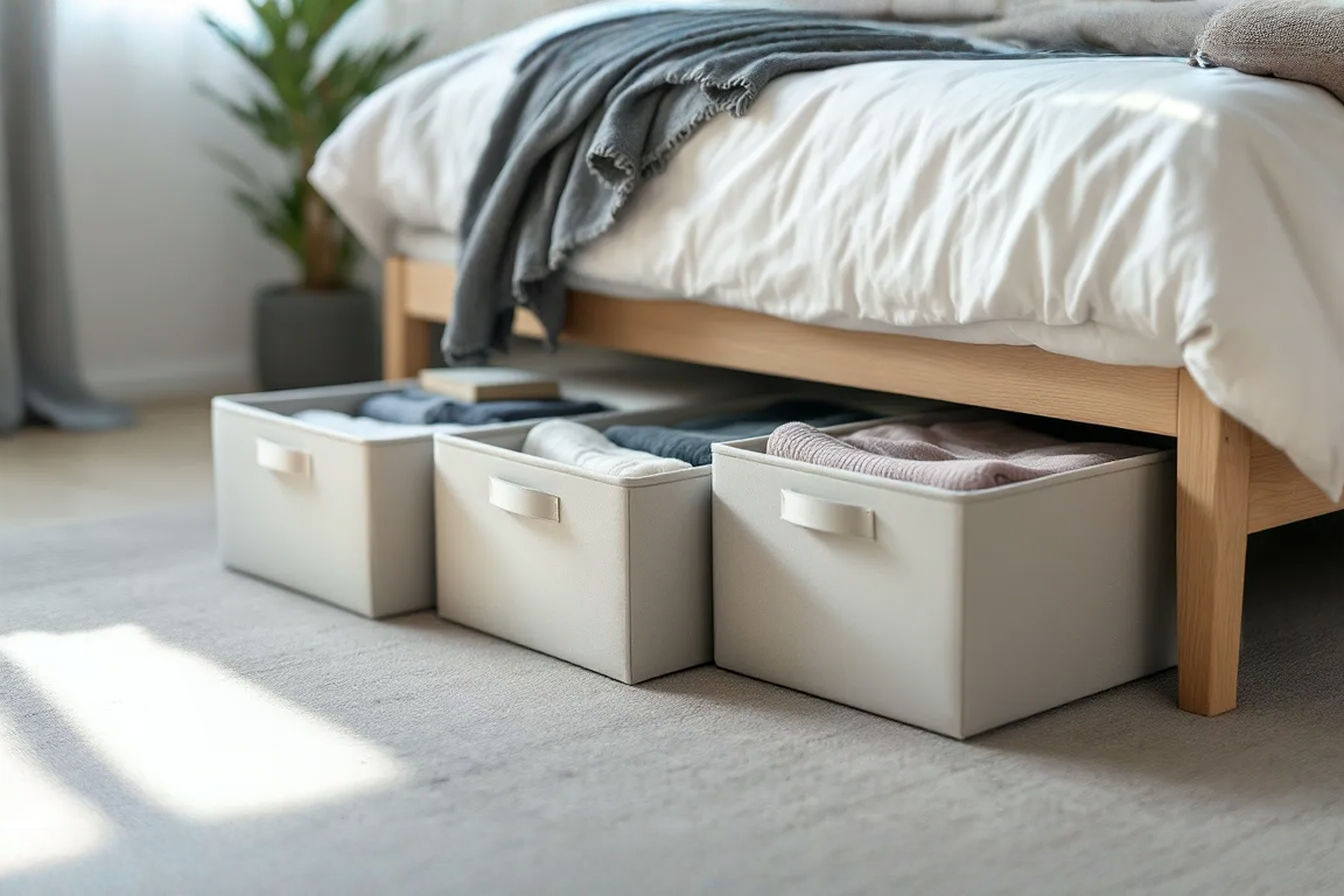
This post may contain affiliate links. If you make a purchase through these links, we may earn a commission at no additional cost to you.
Your bedroom is your personal sanctuary, a place to relax and recharge. But sometimes, it can feel more like a cluttered storage unit than a peaceful retreat. Finding enough space for all your stuff is a common challenge, especially in smaller homes or apartments. We cram things into closets, pile them on chairs, and maybe even stack boxes in corners. There’s one often-overlooked area, though, that holds huge potential for organization and space-saving: the space right under your bed.
This seemingly empty void beneath your mattress can be transformed from a dust bunny haven into a smart, accessible storage zone. Imagine reclaiming closet space or finally putting away those seasonal items without needing to rent an external storage unit. Utilizing the area under your bed isn’t just about hiding clutter; it’s about smartly organizing your belongings, making your room feel bigger, and creating a more peaceful living environment.
This guide will show you how to unlock the hidden potential beneath your bed. We’ll explore different storage methods, share creative ideas for what you can store, and give you practical tips for keeping the space organized and clean. Get ready to see the area under your bed in a completely new light.
The Untapped Potential Under Your Bed
Think about it. Most beds sit several inches, sometimes even a foot or more, off the ground. That creates a significant horizontal area that often goes unused, except maybe for lost socks and dust. This forgotten zone represents valuable real estate, especially in bedrooms where floor space is limited.
Maximizing bedroom space is crucial for comfort and function. When your room feels cramped and cluttered, it’s harder to relax. A messy environment can even contribute to stress. By effectively using the space beneath your bed, you can free up floor space, make your room feel larger and more open, and create a more organized system for your belongings. It’s like adding extra storage without needing any extra square footage. This hidden space is prime for things you don’t need every single day but still want to keep easily accessible.
Getting Started: Planning Your Under Bed Storage
Before you start shoving things under the bed, it’s smart to make a plan. A little preparation goes a long way in creating an organized and functional storage system. You wouldn’t pack for a trip without knowing where you’re going, right? The same idea applies here.
Assess Your Storage Needs
First, figure out what you actually need to store. Take a look around your bedroom. What items are causing clutter? What’s overflowing from your drawers or closet? Common culprits include out-of-season clothing, extra bedding, shoes, books, or hobby supplies. Make a list of the types of items and estimate how much space they’ll require. This assessment helps you choose the right storage solutions later on. Don’t forget to think about things you might need to store in the future, too.
Measure Your Under Bed Space
Not all under bed spaces are created equal. The amount of vertical clearance between your bed frame and the floor is the most important measurement. Some beds are very low, offering only a few inches, while others are higher. You also need to consider the depth and width of the usable area. Measure from the edge of the bed frame inward and between any legs or support beams. Knowing these dimensions is critical for selecting containers and systems that will actually fit. A tape measure is your best friend here. Write down these measurements so you have them handy when shopping.
Declutter Before You Organize
This is a crucial step that many people skip. Before you store anything, go through the items you plan to put under the bed. Get rid of anything you don’t need, use, or love anymore. This could mean donating, selling, or discarding items. Storing things you don’t actually want is a waste of valuable space, even if it’s hidden. Decluttering first ensures you’re only organizing items that are truly worth keeping. It makes the whole process more efficient and the end result more effective. Be honest with yourself about what you really need to keep.
Types of Under Bed Storage Solutions
Once you know what you’re storing and how much space you have, you can explore the different types of storage solutions available. The market offers a wide variety, from simple boxes to integrated furniture. Choosing the right type depends on your needs, your budget, and the style of your room.
Pull-Out Drawers
Pull-out drawers are a popular and convenient option. They often slide out smoothly on casters or runners, providing easy access to contents.
Built-In Under Bed Drawers
Some bed frames come with drawers already built into the base. These are a seamless solution and offer integrated storage that matches the bed’s design. Storage beds with built-in drawers are designed specifically to maximize this space. They often feature multiple drawers on the sides or at the foot of the bed. The drawers are typically constructed from wood or composite materials, featuring sturdy runners for smooth operation. This type of storage is very accessible and keeps items neatly hidden. It’s a great option if you’re buying a new bed and need significant built-in storage. The number and size of drawers vary depending on the bed frame style and size.
Standalone Under Bed Drawers
You can also purchase standalone drawer units designed to slide under your existing bed. These usually have wheels (casters) on the bottom, allowing you to easily pull them out. They come in various materials, including wood, plastic, or fabric-covered frames. Standalone drawers offer flexibility; you can add as many as fit and arrange them as needed. They are a good choice if you don’t want to replace your current bed frame but need drawer-style access to your stored items. Look for models with lids or covers to keep dust out. Some feature a simple open-top design, while others have hinged or removable lids.
Storage Boxes and Bins
Storage boxes and bins are perhaps the most common and versatile under bed storage solution. They are available in countless sizes, shapes, and materials.
Material Options
Plastic bins are durable, easy to clean, and often transparent, allowing you to see the contents without opening them. They offer good protection against dust and moisture. Look for sturdy plastic, like polypropylene, which is also often made from recycled materials. Fabric storage bins provide a softer look and are great for clothing or linens. They are often collapsible when not in use, saving space. Many fabric bins feature cardboard inserts for structure and handles for easy pulling. Woven baskets or decorative bins can offer a more stylish aesthetic, blending storage with room decor, though they might not protect against dust as effectively as lidded options. Materials like rattan, wicker, or fabric-covered cardboard are common.
Features to Consider
When choosing boxes and bins, look for features that enhance usability. Lids are essential for protecting contents from dust, pests, and light. Hinged lids are convenient for quick access, while removable lids offer a secure seal. Wheels or casters make it much easier to pull heavy bins in and out from under the bed, preventing scratches on your floor. Some bins have small built-in wheels, while others are designed to sit on rolling platforms. Handles are also important for easy gripping and pulling. They can be cut-out handles, fabric loops, or metal pulls.
Fabric Storage Bags
Fabric storage bags are lightweight and flexible, ideal for soft items like clothing, bedding, and seasonal decor.
Zippered Bags
These are simple fabric envelopes with a zipper closure. They protect contents from dust and have a lower profile than rigid bins, which can be useful for beds with limited clearance. Many have clear plastic tops or windows so you can see what’s inside. Handles make them easy to slide and pull.
Vacuum Seal Bags
For bulky items like winter coats, duvets, or pillows, vacuum seal bags are revolutionary. You place items inside, seal the bag, and then use a vacuum cleaner or hand pump to remove the air. This compresses the items significantly, reducing their volume by up to 70%. The sealed bag also provides excellent protection against dust, moisture, and pests. Once compressed, these bags can be easily slid under the bed, making room for much more than traditional bags or bins. They are made from durable plastic films like polyethylene and nylon.
Ottoman and Lift-Up Beds
These bed frames are specifically designed with integrated storage beneath the entire mattress. They offer the maximum amount of hidden storage space.
Ottoman Beds
An ottoman bed has a hinged mattress base that lifts up, usually with the help of hydraulic gas pistons. This reveals a large storage area underneath the entire bed platform. The storage space is essentially the full size of the bed frame, offering significant capacity for bulky items like luggage, extra bedding sets, or out-of-season wardrobes. The hydraulic mechanism makes lifting the heavy mattress much easier. Once lifted, the base stays open on its own, giving you free access to the storage space.
Lift-Up Beds
Similar to ottoman beds, lift-up beds raise the mattress platform to access storage. Some might use mechanical lifts instead of hydraulics, or lift from the side rather than the end. The key feature is that the entire under bed area is enclosed and accessible by lifting the sleeping surface. This keeps stored items completely out of sight and dust-free. These beds are an excellent solution for serious space-saving, though they represent a larger investment than buying separate containers. Some high-end models may even feature electric lift mechanisms operated by a remote control.
Rolling Platforms
For a custom or DIY approach, rolling platforms can be a simple and effective solution. These are flat platforms, often made from plywood or solid wood, fitted with casters on the bottom. You can place items directly on the platform or put boxes or bags on top.
Simple Rolling Bins
A basic rolling platform can be turned into a rolling bin by adding low sides. This prevents items from sliding off the edges when you pull it out. Using plywood or particleboard for the base and sides, and attaching sturdy casters, you can create custom-sized storage units that fit your exact under bed space. This offers flexibility in storing various items and allows for easy access. You can leave them open or add a simple lid.
Custom-Built Systems
More advanced DIYers might build more complex rolling systems with dividers or multiple levels. These can be designed to hold specific items like wine bottles, art supplies, or even serve as a pull-out desk or workspace. The beauty of rolling platforms is their customizability to fit unusual spaces or specific storage needs. They are often less expensive than manufactured storage furniture but require some basic carpentry skills.
Creative Uses: What to Store Under Your Bed
The space under your bed isn’t just for dusty junk. With the right planning and containers, it can become a highly organized home for a variety of items. Thinking creatively about what you can store here can significantly free up space elsewhere in your room.
Seasonal Clothing and Linens
This is one of the most popular uses for under bed storage, and for good reason. Items like bulky winter sweaters, heavy coats, summer clothes, extra blankets, duvets, or seasonal bedding take up a lot of closet and linen cupboard space.
Storing Out-of-Season Attire
Use vacuum seal bags to compress puffy jackets and sweaters. Fabric storage bags or lidded plastic bins are excellent for protecting clothing from dust and keeping them organized by season. You can store a whole wardrobe of off-season clothes neatly tucked away. Label the containers clearly (“Winter Clothes,” “Summer Wardrobe”) so you know exactly which one to pull out when the seasons change. Adding cedar blocks or lavender sachets can help keep clothes smelling fresh and deter moths.
Organizing Extra Bedding
Spare sheets, duvet covers, pillows, and blankets can consume valuable closet shelves. Fold them neatly and store them in large fabric bags or plastic bins under the bed. Keep full sets together in one bag or box for easy access. This frees up your linen closet for items you use more frequently, like towels. Using vacuum seal bags is also great for compressing bulky duvets and pillows, making them much more manageable.
Shoes and Accessories
Shoe collections can quickly take over floor space and closet bottoms. The under bed area is perfect for storing pairs you don’t wear every day.
Under Bed Shoe Organizers
There are specific shallow organizers designed to slide under a bed, often with dividers to keep pairs separate. These can be made of fabric, plastic, or cardboard. Some have clear zippered tops for visibility and dust protection. Rolling shoe trays or boxes with wheels make it easy to access your collection. You can typically fit many pairs of shoes in a relatively small under bed footprint this way.
Storing Other Accessories
Beyond shoes, you can use small bins or divided containers under the bed for accessories like scarves, belts, handbags (stored flat), hats, or even costume jewelry. Keep delicate items protected in soft bags or lined boxes. Using clear containers or labels helps you quickly find the accessory you need to complete an outfit.
Books, Magazines, and Media
If you’re a reader or collector, books, magazines, CDs, or DVDs can pile up quickly. Under bed storage offers a discreet place to keep them.
Organizing Your Under Bed Library
Shallow, sturdy bins or drawers are ideal for books and magazines. Ensure the containers can support the weight, as books can be heavy. You can arrange them spine-up or spine-down depending on the height clearance. Rolling bins are great for larger collections. For media, use divided containers or slim boxes to keep items upright and organized. This frees up shelf space in your room for decorative items or things you access more often.
Protecting Paper and Media
Use lidded containers to protect books and media from dust and potential moisture. Consider using acid-free storage boxes for valuable or delicate items like old photographs or important documents stored with media. Keeping them in a cool, dry place under the bed (assuming your room is temperature-controlled) is generally fine for most items.
Important Documents and Keepsakes
Need a safe, out-of-the-way place for important papers or cherished mementos? The space under your bed can serve this purpose.
Storing Sensitive Items
Use sturdy, lidded, and potentially fire-resistant or water-resistant boxes for important documents like birth certificates, passports, or financial records. While not a substitute for a safe or safety deposit box, storing them under the bed can be more secure than leaving them in accessible drawers or shelves. Similarly, keepsakes like photo albums, letters, or small sentimental objects can be stored in protective boxes or containers.
Keeping Items Organized and Safe
Use file boxes or dividers within a larger container to keep documents organized. For keepsakes, wrap delicate items in tissue paper or bubble wrap before placing them in boxes. Ensure the containers have secure lids to protect against dust and potential damage. Labeling the boxes clearly will help you locate specific items when needed. This method keeps sensitive or sentimental items close by but out of daily view.
Luggage and Travel Gear
Storing empty suitcases and travel bags can be a major space hog in closets or garages. The large, open area under an ottoman bed is perfect for these bulky items.
Fitting Luggage Under the Bed
Measure the height of your largest suitcases or duffel bags to ensure they’ll fit under your bed frame. Ottoman beds or beds with significant under-bed clearance are best for this. You might be able to slide smaller bags under even a lower bed frame. Storing luggage here keeps it out of the way when not in use but easily accessible when it’s time to pack for a trip. It’s a practical solution for items that are used infrequently but take up a lot of space.
Craft Supplies and Hobby Gear
If you have hobbies like crafting, sewing, painting, or collecting, you likely have supplies that need organizing. The under bed area can store these items without cluttering your workspace.
Organizing Supplies by Hobby
Use modular bins or containers with dividers to organize craft supplies like fabric, yarn, art supplies, or tools. Clear containers are helpful for seeing contents at a glance. Rolling carts or platforms can be built to slide under the bed, holding multiple containers of supplies. This keeps your creative space tidy while keeping all your materials readily available when inspiration strikes.
Keeping Projects Tidy
You can also store ongoing projects in flat bins or boxes under the bed. This keeps your workspace clear at the end of a crafting session and prevents unfinished projects from creating clutter around your room. Using lidded containers protects your supplies and projects from dust and potential damage.
Toys and Games
For children’s rooms (or adults who love board games!), the under bed area is fantastic for toy and game storage.
Making Cleanup Easy
Use large, durable bins with lids for storing toys. Rolling bins are especially useful in kids’ rooms for easy access and cleanup. You can sort toys by type (blocks, dolls, cars) into different bins. For board games, use shallow boxes that fit the game dimensions, or remove game components and store them in smaller labeled bags or containers within a larger under bed bin.
Keeping Play Areas Clear
Storing toys and games under the bed helps keep the main play area clear and organized. It teaches kids (and reminds adults!) that everything has a designated spot. This can make bedtime cleanup much less of a hassle. Ensure the containers are easy for children to access and handle safely.
Gifts and Holiday Decorations
Have a stash of gifts you’ve bought ahead of time, or a collection of holiday decorations that only come out once a year? The space under your bed is a great place to keep them out of sight but still accessible.
Storing Seasonal Items
Use labeled bins or boxes for different holidays or gift recipients. Flat, lidded containers work well for storing wrapping paper, ribbons, and gift bags. Holiday decorations like ornaments (stored in protective containers), lights, or festive linens can be packed away in labeled bins until the season arrives. This keeps these items organized and prevents them from cluttering other storage areas in your home.
Keeping Track of Contents
Clearly label boxes with the contents, such as “Christmas Decorations,” “Birthday Gifts – Family,” or “Halloween Stuff.” This makes it easy to find what you need when the time comes. Use sturdy boxes that can withstand being slid in and out.
Beyond Storage: Unexpected Uses for Under Bed Space
While storage is the primary function, the space under your bed can sometimes be used in more creative and unconventional ways, especially with higher bed frames or loft beds.
Hidden Workspace or Nook
With a high enough bed, the area underneath can be transformed into a small, hidden workspace or a cozy reading nook.
Creating a Compact Desk Area
A rolling platform with a built-in desk surface can slide out when needed. You can incorporate storage for office supplies or books into the rolling unit. This is ideal for small apartments or dorm rooms where a dedicated desk isn’t feasible. When the work is done, the desk slides back under the bed, keeping the room tidy. You might need to sit on the floor or a low stool to use this kind of setup comfortably.
Building a Cozy Retreat
For a reading nook, add cushions, a small rug, and maybe some string lights or a clip-on lamp under a raised bed. It becomes a private, cozy spot to relax with a book or tablet. This is particularly popular in children’s rooms with mid-sleeper or high sleeper beds. The space feels like a secret hideaway.
Pet Retreat
If you have a pet, the space under your bed can become their own little den.
Creating a Comfortable Den
Place a pet bed or comfortable blanket under the bed. The enclosed space can make pets feel secure and safe. This works best if your pet naturally gravitates towards small, den-like spaces. Ensure there are no hazards or sharp objects under the bed that could harm your pet. Keep the area clean and free of dust.
Secret Safe Spot
While not a high-security vault, the hidden nature of the under bed area can serve as a discreet spot for items you want to keep out of immediate sight.
Concealing Valuables Discreetly
Use a non-descript box or container to store small valuables, emergency cash, or personal items you want to keep private. Tuck it towards the back of the under bed space where it’s less likely to be easily discovered. This isn’t a foolproof security measure, but it adds an extra layer of discretion compared to storing items in more obvious places.
Organizing Like a Pro: Tips for Under Bed Storage
Simply putting things under the bed isn’t true organization. To make the most of this space and keep it functional, follow these tips.
Categorize and Contain
Don’t just mix everything together. Group similar items – all your winter sweaters in one bin, all your shoes in another. Using separate containers for different categories makes it easy to find what you’re looking for without pulling everything out. This system prevents the under bed area from becoming a chaotic dumping ground. Think of each container as a mini-drawer for a specific type of item.
Label Everything
This step is non-negotiable for effective organization. Use clear, easy-to-read labels on the outside of every box, bin, or bag. Write down the contents of each container. This saves you time and effort by allowing you to quickly identify the location of specific items without having to open multiple containers. You can use label makers, sticky labels, or even just write directly on the container with a marker (if the material allows). Be specific with your labels. “Winter Clothes – Sweaters & Jeans” is more helpful than just “Clothes.”
Utilize Vertical Space Within Containers
Even in shallow under bed containers, you can often stack items vertically or use dividers to maximize the space inside each box. Fold clothing neatly and stack it upwards. Use shoe boxes or dividers within a larger bin to keep footwear organized. This ensures you’re using the full capacity of each container. Rolling or folding items smartly can create more space within the container.
Protect from Dust and Pests
The floor is a prime spot for dust accumulation. Use containers with tight-fitting lids or zippered closures to protect your stored items from dust. Fabric bags should be tightly woven. For added protection against pests like moths or silverfish, consider using cedar blocks, lavender sachets, or other natural deterrents within your storage containers, especially for clothing or textiles. Regularly cleaning the area around and under the bed also helps.
Plan for Accessibility
Think about how often you’ll need to access the items you’re storing. Place items you use less frequently (like holiday decorations) towards the back or in harder-to-reach spots. Keep items you might need more often (like extra blankets) closer to the edge of the bed, in rolling containers, or in easily pull-out drawers. This minimizes the effort required to retrieve items. Consider the weight of the containers when planning; lighter items are easier to manage in less accessible spots.
DIY Under Bed Storage Projects
If you’re feeling crafty and want a custom solution, building your own under bed storage isn’t as hard as you might think. Here are a few simple DIY ideas.
Simple Rolling Bins
This is one of the easiest projects. You’ll need a piece of plywood or sturdy board cut to size, four swivel casters (small wheels that can rotate in any direction), screws, and maybe some wood glue.
Building the Base
Cut the plywood to the desired dimensions, ensuring it fits under your bed with some clearance. Lightly sand the edges to prevent splinters. Mark the spots where you’ll attach the casters, typically one near each corner. Drill pilot holes to make screwing easier and prevent the wood from splitting.
Attaching the Casters
Attach the swivel casters to the underside of the plywood using screws. Make sure the screws are the correct length so they don’t poke through the top of the platform. Use a drill or screwdriver to secure them firmly. You can add low sides using thin pieces of wood or even just use the rolling platform as a base for other boxes or bags. Add handles to the front for easy pulling. You can paint or stain the wood to match your decor or leave it natural.
Repurposing Old Drawers
Got an old dresser or cabinet that’s seen better days? You can often salvage the drawers and turn them into rolling under bed storage.
Giving Old Drawers New Life
Remove the drawers from the old furniture. Clean them thoroughly. If needed, repair any loose joints or damage. Attach four swivel casters to the bottom of each drawer, one near each corner. You might need to add a thin piece of plywood or reinforce the bottom if it’s not sturdy enough to support the weight of the contents and the casters. You can paint or decorate the drawers to fit your bedroom style. This is an eco-friendly way to create unique storage.
Building a Platform with Storage
For a more ambitious project, you could build a raised platform bed frame with integrated storage spaces underneath. This typically involves building a sturdy frame from lumber, creating compartments or spaces for bins and drawers to slide into, and then placing your mattress on top. This requires basic carpentry skills and tools like a saw, drill, and level. While more complex, it offers a fully customized storage solution that is part of the bed structure itself. You can design the compartments to fit specific containers or even build in dividers.
Maintaining a Clean and Tidy Under Bed Area
Even with the best storage solutions, the area under your bed can still accumulate dust. Regular cleaning is important for hygiene and keeping your stored items in good condition.
Regular Cleaning Schedule
Make cleaning under the bed a part of your regular routine. This could be once a month, every few months, or seasonally, depending on how quickly dust gathers in your home. Choose a day when you can easily pull out all the storage containers.
Tools for Reaching Under
Traditional vacuum cleaners can struggle to reach far under a low bed. Use vacuum attachments like a crevice tool or extension wand to get into tight spots and corners. A flat-head mop with a microfiber cloth or a dust mop can also reach under lower frames to collect dust bunnies. For a very low bed, a long stick with a microfiber cloth attached (secured with a rubber band) works well. You might need to get down on your hands and knees to reach effectively.
Keeping Stored Items Clean
Periodically, take the items out of your under bed storage containers. If they are washable (like clothing or linens), wash them before returning them to storage. Wipe down the inside and outside of storage bins and boxes with a damp cloth to remove dust. Ensure everything is completely dry before putting items back and closing the lids to prevent mold or mildew. Replacing cedar blocks or lavender sachets regularly helps keep items fresh.
Choosing a Bed Frame for Maximum Storage
If you’re in the market for a new bed, consider frames designed with storage in mind. These can offer significantly more integrated space than standard frames.
Divan Beds with Drawers
Divan beds have a solid base (often made of wood) that sits directly on the floor or on low feet. The base typically incorporates pull-out drawers on the sides or at the foot. These beds don’t have an open space underneath like a standard frame; the storage is built into the base itself. They offer a good amount of storage in a compact footprint. The number and configuration of drawers can vary.
Ottoman Beds
As mentioned earlier, ottoman beds are designed specifically for maximum under bed storage. The entire mattress base lifts up to reveal a large, open storage area beneath. This is ideal for storing bulky items that wouldn’t fit in drawers. They come in various styles and materials, from upholstered frames to wooden designs.
High Sleeper or Loft Beds
While often associated with children’s rooms, high sleeper or loft beds elevate the mattress significantly off the ground. This creates a large, open area underneath that can be used for a variety of purposes beyond storage, such as a desk area, seating area, or even a small wardrobe. If using the space for storage, you have much more vertical clearance to work with and can use taller storage units or shelves.
Conclusion: Reclaim Your Room
The space under your bed is more than just an empty void; it’s a valuable and often-underutilized storage resource. By planning effectively, choosing the right storage solutions, and thinking creatively about what you can store, you can transform this hidden area into a powerful tool for organization.
Whether you opt for simple rolling bins, invest in a storage-focused bed frame, or tackle a DIY project, utilizing the space beneath your bed can help you reduce clutter, free up valuable floor space, and create a more peaceful and functional bedroom environment. Don’t let this hidden gem go to waste. Unlock the potential under your bed and reclaim your room from clutter. Start small with a few bins, or go big with a full ottoman bed – either way, you’ll appreciate the extra space and the feeling of a more organized home. It’s time to make every inch of your bedroom work for you.

